T.S. Rhodes's Blog, page 2
January 9, 2018
The Buccaneers TV Show
Okay – It’s cold, the sky is grey, and a lot of us are sitting at home, thanking heaven for central heating and wishing that new episodes of Black Sails were still coming out.
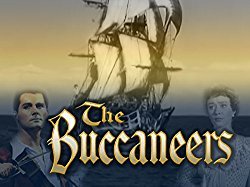 As seen on AmazonNever fear. Today I present to you a TV show that folks in the US have probably never seen. It’s available on Amazon Prime right now, and DVD’s of the series are available for less than $10.I’m talking about the 1956 British series The Buccaneers, a children’s show starring Robert Shaw (who also played Quint in Jaws.) And before you say “kid’s series,” and flee, this is not quite “Jake and the Neverland Pirates.” Remember Dr. Who, which also started out as a kid’s series at about the same time. It turned out ok.
As seen on AmazonNever fear. Today I present to you a TV show that folks in the US have probably never seen. It’s available on Amazon Prime right now, and DVD’s of the series are available for less than $10.I’m talking about the 1956 British series The Buccaneers, a children’s show starring Robert Shaw (who also played Quint in Jaws.) And before you say “kid’s series,” and flee, this is not quite “Jake and the Neverland Pirates.” Remember Dr. Who, which also started out as a kid’s series at about the same time. It turned out ok.
The year is 1720. Though Shaw was supposed to be the star, he was not available for shooting when the first two episodes were produced. At first the series seems to be about a real person, Woods Rogers, as he shows up to take over the position of Governor to the island of Nassau in the Bahamas. Given the fact that Rogers is supposed to be a good guy in the 1950’s mold (kind, wise, and good-looking) the transfer of power goes off in a surprisingly historical fashion. The island is in chaos, but Roger’s offer of pardons brings most of the pirates to heel.
 Woods Rodgers didn't actually look like this.
Woods Rodgers didn't actually look like this.
We get a good, quick look at Ben Hornigold, Jack Rackham, Charles Vane and Blackbeard, and all behave in a way that’s fairly close to history. It’s important to note that someone seemed to want to use this show to teach British history to children, so a high percentage of the details are right. I also think that the time period of the show – 1956, when service men who had served in WWII were still settling down after the war. After all, the arrival of Rogers in the islands signaled a “taming” of pirates, just as the people of the 1940’s and early 50’s were expected to turn their backs on the wild lives they had lived before.
It’s the third episode before Shaw, in the form of pirate captain Dan Tempest. Too late to accept the pardon, Tempest is arrested for piracy, and then given a chance to redeem himself by captaining a trade ship to Jamaica. He encounters Blackbeard along the way, wins and engagement, and somewhat redeems himself. Tempest considers still considers himself a pirate.
 Robert Shaw
Robert Shaw
Now, remember that these are half-hour episodes, created in black-and-white half a century ago. But by this time I was already seeing things about this series that I really liked. Little things like the fact that some of the ships have tillers instead of wheels for steering. (The early 1700s were a period of transitions between the two.) Also, some of the pirates wear their 3-cornered hats with a flat side in the front instead of a point, which is also historically accurate. When the sailors move heavy objects, such as cannons, they use correct the correct knots in the ropes.
Little things like this go a long way with me. Simply put, this early TV series is not tied down to decades of cinematic pirate lore, so different from actual history. The series had the use of a real ship, and made good use of it, showing some actual sailing, with correct orders being given, and the actions of sails, line and anchors makes sense. Britain has always been a sailing nation, and put at least as much concern into historic ships as America does into cowboy epics. In addition, in 1956 some sailing ships were still hauling cargo professionally.
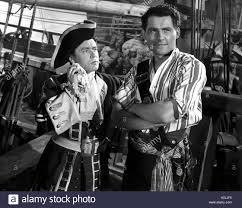
As the show went on, I saw issues being dealt with that you don’t see in modern movies. Slavery, for instance. Dan Tempest doesn’t like slavery, but the practice was perfectly legal during his time. When he encounters a ship full of rebellious slaves (both Black and White, it should be noted), what does he do about it? Other episodes deal with shortages of gunpowder, diseases such as typhus, relations with Native Americans, the scarcity of women, and issues with the legal rights of indentured servants. And most of the classic “Pirate’s Articles” are repeated by a group that’s going out “on the account.” Including, “Lights out by 8:00” and, “no drinking below decks.” Someone did quite a bit of homework.
And throughout all of this is Dan Tempest. Robert Shaw plays a pirate as I have always liked my pirates to be played. He moves and speaks and acts as if life may be over at any moment, and he needs to wring all the pleasure possible out of it right now. He drinks, fights, and talks back to authority figures with an enthusiastic pirate spirit. This is the first time Shaw sang “Farewell Spanish Ladies” on screen, and also the show that taught him to fight with a sword.
Early episodes try to make him into a farmer in the island’s interior, but he quickly finds his way back onto the high seas. Early episodes also ty to tie him down to a wife and family. (See above: the taming of the pirates.) But, whether because the show wasn’t doing as well as the sponsors would have liked, or because whoever wanted the moralizing tone worked into the program let their attention wander to some other project, Dan Tempest does not settle down as expected.
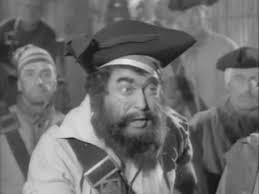 Blackbeard is the bad guyThe fiery Spanish tavern-singer who has been the love of his life runs off the Jamaica, leaving only a note saying, “I don’t cook, I don’t clean!” Dan himself does not seem to be too honest. If bags of gold aren’t being watched, he’s perfectly willing to pocket them. Even when he’s trying to “go straight” he practices some sharp trading. He’s also willing to kiss a lady or two, even if she’s being courted by someone else.
Blackbeard is the bad guyThe fiery Spanish tavern-singer who has been the love of his life runs off the Jamaica, leaving only a note saying, “I don’t cook, I don’t clean!” Dan himself does not seem to be too honest. If bags of gold aren’t being watched, he’s perfectly willing to pocket them. Even when he’s trying to “go straight” he practices some sharp trading. He’s also willing to kiss a lady or two, even if she’s being courted by someone else.
The Buccaneers makes good use of its budget for sets, but this is no Black Sails. Some of the fight scenes are laughable, with actors obviously pulling punches and missing hits. A few of the episodes are obviously padded out, with lots of shouting about the same thing over and over instead of character development. But all-in-all it’s a very pleasant surprise.
I’m watching it one episode a day, to make it last.
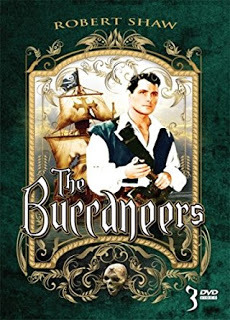
 As seen on AmazonNever fear. Today I present to you a TV show that folks in the US have probably never seen. It’s available on Amazon Prime right now, and DVD’s of the series are available for less than $10.I’m talking about the 1956 British series The Buccaneers, a children’s show starring Robert Shaw (who also played Quint in Jaws.) And before you say “kid’s series,” and flee, this is not quite “Jake and the Neverland Pirates.” Remember Dr. Who, which also started out as a kid’s series at about the same time. It turned out ok.
As seen on AmazonNever fear. Today I present to you a TV show that folks in the US have probably never seen. It’s available on Amazon Prime right now, and DVD’s of the series are available for less than $10.I’m talking about the 1956 British series The Buccaneers, a children’s show starring Robert Shaw (who also played Quint in Jaws.) And before you say “kid’s series,” and flee, this is not quite “Jake and the Neverland Pirates.” Remember Dr. Who, which also started out as a kid’s series at about the same time. It turned out ok.The year is 1720. Though Shaw was supposed to be the star, he was not available for shooting when the first two episodes were produced. At first the series seems to be about a real person, Woods Rogers, as he shows up to take over the position of Governor to the island of Nassau in the Bahamas. Given the fact that Rogers is supposed to be a good guy in the 1950’s mold (kind, wise, and good-looking) the transfer of power goes off in a surprisingly historical fashion. The island is in chaos, but Roger’s offer of pardons brings most of the pirates to heel.
 Woods Rodgers didn't actually look like this.
Woods Rodgers didn't actually look like this.We get a good, quick look at Ben Hornigold, Jack Rackham, Charles Vane and Blackbeard, and all behave in a way that’s fairly close to history. It’s important to note that someone seemed to want to use this show to teach British history to children, so a high percentage of the details are right. I also think that the time period of the show – 1956, when service men who had served in WWII were still settling down after the war. After all, the arrival of Rogers in the islands signaled a “taming” of pirates, just as the people of the 1940’s and early 50’s were expected to turn their backs on the wild lives they had lived before.
It’s the third episode before Shaw, in the form of pirate captain Dan Tempest. Too late to accept the pardon, Tempest is arrested for piracy, and then given a chance to redeem himself by captaining a trade ship to Jamaica. He encounters Blackbeard along the way, wins and engagement, and somewhat redeems himself. Tempest considers still considers himself a pirate.
 Robert Shaw
Robert ShawNow, remember that these are half-hour episodes, created in black-and-white half a century ago. But by this time I was already seeing things about this series that I really liked. Little things like the fact that some of the ships have tillers instead of wheels for steering. (The early 1700s were a period of transitions between the two.) Also, some of the pirates wear their 3-cornered hats with a flat side in the front instead of a point, which is also historically accurate. When the sailors move heavy objects, such as cannons, they use correct the correct knots in the ropes.
Little things like this go a long way with me. Simply put, this early TV series is not tied down to decades of cinematic pirate lore, so different from actual history. The series had the use of a real ship, and made good use of it, showing some actual sailing, with correct orders being given, and the actions of sails, line and anchors makes sense. Britain has always been a sailing nation, and put at least as much concern into historic ships as America does into cowboy epics. In addition, in 1956 some sailing ships were still hauling cargo professionally.

As the show went on, I saw issues being dealt with that you don’t see in modern movies. Slavery, for instance. Dan Tempest doesn’t like slavery, but the practice was perfectly legal during his time. When he encounters a ship full of rebellious slaves (both Black and White, it should be noted), what does he do about it? Other episodes deal with shortages of gunpowder, diseases such as typhus, relations with Native Americans, the scarcity of women, and issues with the legal rights of indentured servants. And most of the classic “Pirate’s Articles” are repeated by a group that’s going out “on the account.” Including, “Lights out by 8:00” and, “no drinking below decks.” Someone did quite a bit of homework.
And throughout all of this is Dan Tempest. Robert Shaw plays a pirate as I have always liked my pirates to be played. He moves and speaks and acts as if life may be over at any moment, and he needs to wring all the pleasure possible out of it right now. He drinks, fights, and talks back to authority figures with an enthusiastic pirate spirit. This is the first time Shaw sang “Farewell Spanish Ladies” on screen, and also the show that taught him to fight with a sword.
Early episodes try to make him into a farmer in the island’s interior, but he quickly finds his way back onto the high seas. Early episodes also ty to tie him down to a wife and family. (See above: the taming of the pirates.) But, whether because the show wasn’t doing as well as the sponsors would have liked, or because whoever wanted the moralizing tone worked into the program let their attention wander to some other project, Dan Tempest does not settle down as expected.
 Blackbeard is the bad guyThe fiery Spanish tavern-singer who has been the love of his life runs off the Jamaica, leaving only a note saying, “I don’t cook, I don’t clean!” Dan himself does not seem to be too honest. If bags of gold aren’t being watched, he’s perfectly willing to pocket them. Even when he’s trying to “go straight” he practices some sharp trading. He’s also willing to kiss a lady or two, even if she’s being courted by someone else.
Blackbeard is the bad guyThe fiery Spanish tavern-singer who has been the love of his life runs off the Jamaica, leaving only a note saying, “I don’t cook, I don’t clean!” Dan himself does not seem to be too honest. If bags of gold aren’t being watched, he’s perfectly willing to pocket them. Even when he’s trying to “go straight” he practices some sharp trading. He’s also willing to kiss a lady or two, even if she’s being courted by someone else.
The Buccaneers makes good use of its budget for sets, but this is no Black Sails. Some of the fight scenes are laughable, with actors obviously pulling punches and missing hits. A few of the episodes are obviously padded out, with lots of shouting about the same thing over and over instead of character development. But all-in-all it’s a very pleasant surprise.
I’m watching it one episode a day, to make it last.

Published on January 09, 2018 19:05
January 2, 2018
The Whores of Old Port Royal
In the days of Captain Morgan – yes, that red-coated fellow on the rum bottle – Port Royal was officially the Wickedest City on Earth. Not only was the place officially an “open port” – a place where pirates were not prosecuted, and could come, go, and sell their ill-gotten goods without interference from the authorities. Not only was it a place nearly drowned in rum, where one in three buildings housed a tavern. But it was also a place where prostitution was legal, and where working women made names for themselves – and fortunes to take back to England.
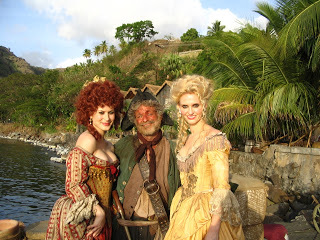
The women were colorful – one could afford to be, in a city filled with pirates. They sported names like Salt-Beef Peg, No-Conscience Nan, and Buttock-de-Clink Jenny. Attitude was everything. A contemporary writes:
“A little Reputation among the Women goes a great way; and if their Actions be answerable to their looks, they may vie (in) Wickedness with the Devil: an Impudent Air, being the only Charms of their Countenance, and a Lewd Carriage the Studied grace of their Deportment. They are such who have been Scandalous in England to the utmost degree, either transported by the State or led by their Vicious Inclinations; (to) where they may be Wicked without Shame, and Whore on without Punishment.”
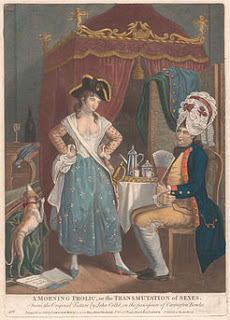
In other words, the Port Royal prostitutes made more money if they had a reputation. They looked like prostitutes, and made no pretense of being anything else. Exactly what made up their “wickedness” is not specified, but this was a time period when women were not supposed to have any sort of independent sexual life. Merely acting “sexy,” or taking lovers for pleasure as well as profit may have been what shocked the writer of the passage above.
Notice that, while some of these women have been “transported” – meaning shipped to the English colonies as punishment for crimes, others have come to the New World out of choice. Why?
The answer is that, when the pirate fleets were in port, money flowed like rain-water. Men were walking around with the equivalent of hundreds of thousands of dollars in their pockets, and also carrying an understanding that disease, injury, enemy weapons or the sea itself might kill them at any moment. They wanted a good time, right now, and were willing to pay for it.
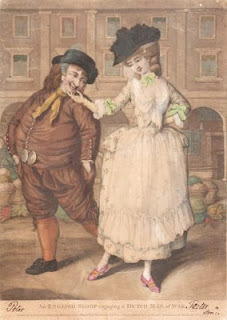
How good a time, and how much money? Three hundred and fifty years have passed since Morgan’s day, but some stories remain. In one case, a pirate paid a certain woman the modern equivalent of $25,000 merely to strip naked. (Women’s clothing of the time was so bulky and hard to take off that women who did not have servants rarely removed all of it. Prostitutes serviced customers by lifting their skirts, even if they had a room for the night.)
But most famous of the ladies of Port Royal was Mary Carleton. She had been born in the English district of Canterbury, daughter of a fiddler. But in 1663 she rode a barge into London, walked into the first tavern that would admit a woman, and became Maria von Wolway, a German princess, running away from an arranged marriage. Mary claimed that her common clothing was a disguise, and that she was a rich orphan who had left estates and jewels behind her because she wanted to marry for love.
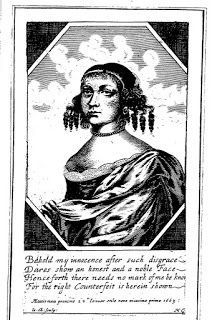 A contemporary portrait of Mary Carleton
A contemporary portrait of Mary Carleton
She threw herself on “the kindness of strangers” and since she was pretty, and presumably rich, she found no shortage of kindness. She quickly married a man named John Carleton who thought he was getting a prize. It soon turned out that Mary was not only not German and not a princess, but that she was already married to a shoemaker named Thomas Stedman, and had borne him two children, neither of which had survived.
In the mid-1600s divorce was impossible. But John Carleton took Mary to court for bigamy and false representation. Mary countered by accusing her husband of falsely representing himself as a lord. Both sides published pamphlets publicizing their side of the conflict. The case became a popular scandal, the talk of taverns and coffee houses all over London.
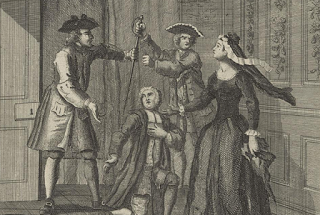 Mary on stage
Mary on stage
At her trial, Mary announced that, even though she wasn’t a princess, she had worked hard to cultivate the accomplishments of one, and that ought to count for something. She was acquitted. After the trial, she wrote an autobiography (probably ghost-written) and starred in a play about her life. This brought her more admirers. Once of them persuaded her to marry him. Shortly after she did, Mary ran off with his money, valuables, and keys while he was drunk.
For the next ten years, Mary made a career of pretending to be a rich virgin heiress on the run from an arranged marriage. She duped many men and stole many valuables, often from husbands who were too embarrassed to admit they’d been taken. She was finally convicted of stealing a sliver tankard and sentenced to penal transportation - in other words, she was thrown out of England and sent to live in Port Royal.

For two years she was the toast of the wicked town. She may have had sex with Morgan himself. She certainly serviced his men. But Port Royal lacked the thing that Mary loved – gullible guys who wanted to marry a rich virgin. Pirates were more direct, less inclined to marry, and apparently more impressed with practiced skill than blushing virginity. After two years, Mary stowed away on a ship and went back to England, where she was soon up to her old tricks.
In many ways, Mary Carleton was like the pirates she knew. Though she made an enormous amount of money over the course of her life – not only stealing valuables, but receiving many rich presents from men who courted her – she never used the money to set up a comfortable life for herself. She seems to have been addicted to the thrill of the chase. I believe that it is significant that she never pretended to be a rich widow – only a virgin heiress. Apparently playing this part was more important to her than life itself. In December of 1672 she was captured when a man searching for stolen loot recognized her. She was tried in the Old Bailey. Because she had returned from penal transportation without permission, the sentence was death, and Mary was executed by hanging on January 22, 1673.
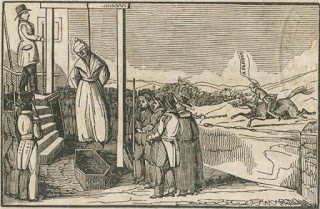

The women were colorful – one could afford to be, in a city filled with pirates. They sported names like Salt-Beef Peg, No-Conscience Nan, and Buttock-de-Clink Jenny. Attitude was everything. A contemporary writes:
“A little Reputation among the Women goes a great way; and if their Actions be answerable to their looks, they may vie (in) Wickedness with the Devil: an Impudent Air, being the only Charms of their Countenance, and a Lewd Carriage the Studied grace of their Deportment. They are such who have been Scandalous in England to the utmost degree, either transported by the State or led by their Vicious Inclinations; (to) where they may be Wicked without Shame, and Whore on without Punishment.”

In other words, the Port Royal prostitutes made more money if they had a reputation. They looked like prostitutes, and made no pretense of being anything else. Exactly what made up their “wickedness” is not specified, but this was a time period when women were not supposed to have any sort of independent sexual life. Merely acting “sexy,” or taking lovers for pleasure as well as profit may have been what shocked the writer of the passage above.
Notice that, while some of these women have been “transported” – meaning shipped to the English colonies as punishment for crimes, others have come to the New World out of choice. Why?
The answer is that, when the pirate fleets were in port, money flowed like rain-water. Men were walking around with the equivalent of hundreds of thousands of dollars in their pockets, and also carrying an understanding that disease, injury, enemy weapons or the sea itself might kill them at any moment. They wanted a good time, right now, and were willing to pay for it.

How good a time, and how much money? Three hundred and fifty years have passed since Morgan’s day, but some stories remain. In one case, a pirate paid a certain woman the modern equivalent of $25,000 merely to strip naked. (Women’s clothing of the time was so bulky and hard to take off that women who did not have servants rarely removed all of it. Prostitutes serviced customers by lifting their skirts, even if they had a room for the night.)
But most famous of the ladies of Port Royal was Mary Carleton. She had been born in the English district of Canterbury, daughter of a fiddler. But in 1663 she rode a barge into London, walked into the first tavern that would admit a woman, and became Maria von Wolway, a German princess, running away from an arranged marriage. Mary claimed that her common clothing was a disguise, and that she was a rich orphan who had left estates and jewels behind her because she wanted to marry for love.
 A contemporary portrait of Mary Carleton
A contemporary portrait of Mary CarletonShe threw herself on “the kindness of strangers” and since she was pretty, and presumably rich, she found no shortage of kindness. She quickly married a man named John Carleton who thought he was getting a prize. It soon turned out that Mary was not only not German and not a princess, but that she was already married to a shoemaker named Thomas Stedman, and had borne him two children, neither of which had survived.
In the mid-1600s divorce was impossible. But John Carleton took Mary to court for bigamy and false representation. Mary countered by accusing her husband of falsely representing himself as a lord. Both sides published pamphlets publicizing their side of the conflict. The case became a popular scandal, the talk of taverns and coffee houses all over London.
 Mary on stage
Mary on stageAt her trial, Mary announced that, even though she wasn’t a princess, she had worked hard to cultivate the accomplishments of one, and that ought to count for something. She was acquitted. After the trial, she wrote an autobiography (probably ghost-written) and starred in a play about her life. This brought her more admirers. Once of them persuaded her to marry him. Shortly after she did, Mary ran off with his money, valuables, and keys while he was drunk.
For the next ten years, Mary made a career of pretending to be a rich virgin heiress on the run from an arranged marriage. She duped many men and stole many valuables, often from husbands who were too embarrassed to admit they’d been taken. She was finally convicted of stealing a sliver tankard and sentenced to penal transportation - in other words, she was thrown out of England and sent to live in Port Royal.

For two years she was the toast of the wicked town. She may have had sex with Morgan himself. She certainly serviced his men. But Port Royal lacked the thing that Mary loved – gullible guys who wanted to marry a rich virgin. Pirates were more direct, less inclined to marry, and apparently more impressed with practiced skill than blushing virginity. After two years, Mary stowed away on a ship and went back to England, where she was soon up to her old tricks.
In many ways, Mary Carleton was like the pirates she knew. Though she made an enormous amount of money over the course of her life – not only stealing valuables, but receiving many rich presents from men who courted her – she never used the money to set up a comfortable life for herself. She seems to have been addicted to the thrill of the chase. I believe that it is significant that she never pretended to be a rich widow – only a virgin heiress. Apparently playing this part was more important to her than life itself. In December of 1672 she was captured when a man searching for stolen loot recognized her. She was tried in the Old Bailey. Because she had returned from penal transportation without permission, the sentence was death, and Mary was executed by hanging on January 22, 1673.

Published on January 02, 2018 18:35
December 20, 2017
Pirate Santa - Again!
Of all the posts I've made over the years, this is the one I get the most requests to re-post.
Christmas is nearly upon us; it’s time for eggnog, presents and… Pirates?

Well, yes. As a matter of fact, Santa dressed as a pirate, or pirates dressed as Santa, is a “thing”. And it make sense, after all. Both pirate captains and St. Nick lead rag-tag bands of outcasts. (When was the last time you saw an elf in polite society?) And they both have a history of re-distributing wealth.
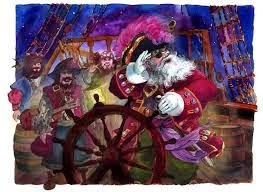
One reason it’s so easy to link the two is that Santa has a backstory that’s s lot more fierce than his current incarnations. The gift-bringer was once known to bring coal (representing the fires of hell) to kids who weren’t good enough. And before that, he was linked to Odin, the Norse father-god who wandered the world and occasionally meted out justice, in the forms of rewards or punishment.
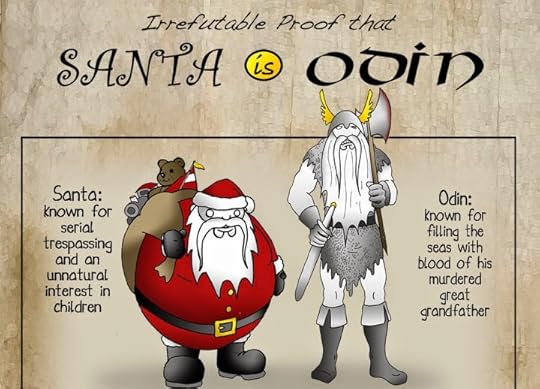
It’s generally believed, even by folks who don’t “Believe” in Santa, that the man in the red suit is a powerful force of nature. In movies like “Rise of the Guardians” he’s a Russian-accented powerhouse, leading the other guardians of childhood to protect the world. In “The Nightmare Before Christmas” Jack Skellington nearly wrecks the holiday, but when Santa is set free at the last minute, he calmly states that he has the power to set everything right by dawn.

So Santa, like a pirate captain, has impressive power, and the ability to travel. He might be carrying anything from gold to coal to the kind of odds and ends that might be accumulating in the hold of a pirate ship – or Santa’s bag of holding.
Both characters are often jolly. And even though Santa is gifted with glasses of milk on Christmas Eve, no one has ever claimed that he doesn’t enjoy a mixed drink after he’s finished driving the sleigh.
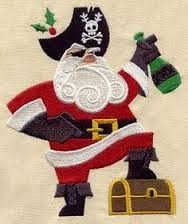
Santa’s long red coat with the white fur cuffs easily translated into an 18th century pirate coat, and red is a color that’s been associated with pirates ever since Captain Morgan donned his best red silk coat while recruiting a privateer navy to fight the Spanish.
Santa’s boots look quite a bit like pirate-style footwear. And various other details – his beard, reminiscent of Blackbeard, his sack full of loot, his wide-buckled black belt – all add to the likeness. Some artists have added a hook hand made from a candy cane, and it blends right in,
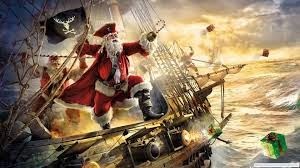
It’s even easy to see Santa in the tropics. After all, he needs some kind of vacation after the big night.Santa as a pirate, or a pirate as Santa, is an image that goes back decades, and has been memorialized in nutcrackers, Christmas ornaments, paintings, and photos.
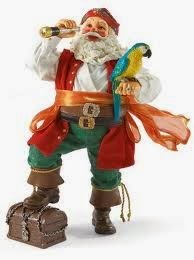
Probably the ultimate link is the children's book, "Pirate Santa" featuring Cap'n Slappy, one of the gentlemen who brought us Talk Like a Pirate Day. The story is one dear to a pirate's heart, about how Slappy, Santa's cousin, sets out to bring Christmas cheer to kids who were a little too - um - nonconforming, to make Santa's "nice" list.
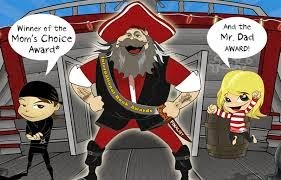
The book makes a grand Christmas gift for a child, and since it's available by download, it can still be purchased in time for the holiday.
Or, for grownups, pick up a copy of my own novels, Gentlemen and Fortune, Bloody Seas, and Storm Season, the tales of my redheaded female pirate captain and her adventures in the man's world of piracy.
As an added bonus this year, I'll gift you with a little Pirate Santa music - enjoy! Yo Ho Ho Ho and a Merry Christmas to all!

Christmas is nearly upon us; it’s time for eggnog, presents and… Pirates?

Well, yes. As a matter of fact, Santa dressed as a pirate, or pirates dressed as Santa, is a “thing”. And it make sense, after all. Both pirate captains and St. Nick lead rag-tag bands of outcasts. (When was the last time you saw an elf in polite society?) And they both have a history of re-distributing wealth.

One reason it’s so easy to link the two is that Santa has a backstory that’s s lot more fierce than his current incarnations. The gift-bringer was once known to bring coal (representing the fires of hell) to kids who weren’t good enough. And before that, he was linked to Odin, the Norse father-god who wandered the world and occasionally meted out justice, in the forms of rewards or punishment.

It’s generally believed, even by folks who don’t “Believe” in Santa, that the man in the red suit is a powerful force of nature. In movies like “Rise of the Guardians” he’s a Russian-accented powerhouse, leading the other guardians of childhood to protect the world. In “The Nightmare Before Christmas” Jack Skellington nearly wrecks the holiday, but when Santa is set free at the last minute, he calmly states that he has the power to set everything right by dawn.

So Santa, like a pirate captain, has impressive power, and the ability to travel. He might be carrying anything from gold to coal to the kind of odds and ends that might be accumulating in the hold of a pirate ship – or Santa’s bag of holding.
Both characters are often jolly. And even though Santa is gifted with glasses of milk on Christmas Eve, no one has ever claimed that he doesn’t enjoy a mixed drink after he’s finished driving the sleigh.

Santa’s long red coat with the white fur cuffs easily translated into an 18th century pirate coat, and red is a color that’s been associated with pirates ever since Captain Morgan donned his best red silk coat while recruiting a privateer navy to fight the Spanish.
Santa’s boots look quite a bit like pirate-style footwear. And various other details – his beard, reminiscent of Blackbeard, his sack full of loot, his wide-buckled black belt – all add to the likeness. Some artists have added a hook hand made from a candy cane, and it blends right in,

It’s even easy to see Santa in the tropics. After all, he needs some kind of vacation after the big night.Santa as a pirate, or a pirate as Santa, is an image that goes back decades, and has been memorialized in nutcrackers, Christmas ornaments, paintings, and photos.

Probably the ultimate link is the children's book, "Pirate Santa" featuring Cap'n Slappy, one of the gentlemen who brought us Talk Like a Pirate Day. The story is one dear to a pirate's heart, about how Slappy, Santa's cousin, sets out to bring Christmas cheer to kids who were a little too - um - nonconforming, to make Santa's "nice" list.

The book makes a grand Christmas gift for a child, and since it's available by download, it can still be purchased in time for the holiday.
Or, for grownups, pick up a copy of my own novels, Gentlemen and Fortune, Bloody Seas, and Storm Season, the tales of my redheaded female pirate captain and her adventures in the man's world of piracy.
As an added bonus this year, I'll gift you with a little Pirate Santa music - enjoy! Yo Ho Ho Ho and a Merry Christmas to all!

Published on December 20, 2017 20:10
December 12, 2017
Libertalia - The Pirate Utopia
As I have mentioned before, Golden Age pirates were pirates with a purpose. The piratical call of “Freedom!” has been preserved through the ages, but the rallying cry of “Give a working man a chance!” has not, even though it was a more common statement at the time. Pirates, representing a variety of people who were being abused by the economic system of the time, were trying to promote a system in which every person had similar opportunities in life, and (at least) enough to eat and a place to live.
Enter Libertalia.
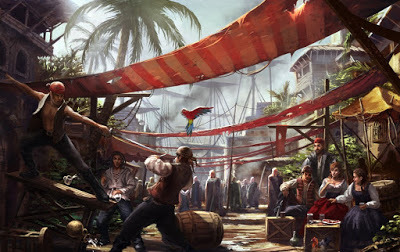
Libertalia was a legendary free colony forged by pirates. It was founded and ruled by the pirate Captain Misson (sometimes spelled Missin) a semi-legendary piratical figure described in The Robberies and Murders of the most Notorious Pyrates (1724).
Historian and activist Marcus Rediker describes the pirates as follows:These pirates who settled in Libertalia would be "vigilant Guardians of the People's Rights and Liberties"; they would stand as "Barriers against the Rich and Powerful" of their day. By waging war on behalf of "the Oppressed" against the "Oppressors," they would see that "Justice was equally distributed."
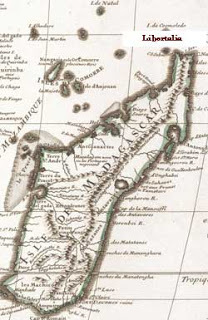
No one knows for sure if Libertatia actually existed. Pirates aren’t noted for keeping good records about their societies. But real or not, the radical ideas that it represented inspired undisputed real-life events. For example, after the American Revolution, a group of pirates fleeing from England were wrecked on an island and set up their own society. They called their new island "the Republic of Spensonia", after a fictional country created by the English author and political reformer Thomas Spence.

These pirates stood against monarchies, slavery, and capitalism as a way of distributing wealth. The pirates practiced a form of direct democracy, (one man one vote) where the crew held the authority to make laws and rules. Their system encouraged leaders to think of themselves as the equals, not the superiors, of those they led.
The pirates insisted that "every Man was born free, and had as much Right to what would support him, as to the Air he respired." They resented the "encroachments" by which "Villains" and "unmerciful Creditors" grew "immensely rich" as others became "wretchedly miserable." They spoke of the "Natural right" to "a Share of the Earth as is necessary for our Support." They saw piracy as a war of self-preservation, and had no need for money "where every Thing was in common, and no Hedge bounded any particular Man's Property," and they decreed that "the Treasure and Cattle they were Masters of should be equally divided."
Libertalia’s motto was said to be "for God and liberty," and its flag was white, in contrast to a Jolly Roger. Thecitizens were anarchists, waging war against states and lawmakers, attacking ships, sparing prisoners, and freeing slaves. It is said that Misson's crews often were equal parts African and European, as he did not support slavery. The pirates of Libertalia called themselves Liberi, and lived under a communal city rule, a sort of worker owned corporation of piracy. They had articles (shared codes of conduct), and used elected systems of re-callable delegates.
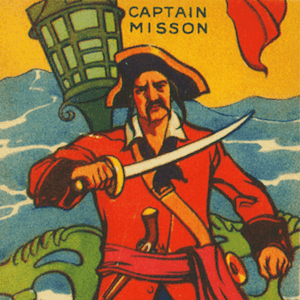
Captain Misson, founder of Libertalia, was French, born in Provence, while in Rome he ran into Caraccioli - a "lewd Priest" who gradually converted Misson and a sizeable portion of his crew to his way of thinking:
he fell upon Government, and shew'd, that every Man was born free, and had as much Right to what would support him, as to the Air he respired... that the vast Difference betwixt Man and Man, the one wallowing in Luxury, and the other in the most pinching Necessity, was owing only to Avarice and Ambition on the one Hand, and a pusillanimous Subjection on the other.
Convinced by the priest’s persuasion, the whole crew became pirates. They shared everything, including the ship, and freed the first cargo of slaves they encountered, urging the Africans to join them as brothers.
Off the coast of Madagascar, Misson found a perfect bay in an area with fertile soil, fresh water and friendly natives. Here the pirates built Libertalia. No more were they English, French, Dutch or African. They were Liberi. They created their own language, a polyglot mixture of African languages, combined with French, English, Dutch, Portuguese and native Malagasy.
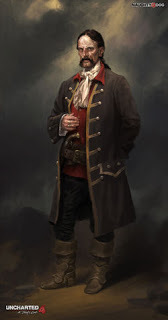 Thomas Tew
Thomas Tew
Shortly after work on the colony began, they were joined by the pirate Thomas Tew. The Liberi - "Enemies to Slavery," aimed to boost their numbers by capturing another slave ship. Off the coast of Angola, Tew's crew took an English slave ship with 240 men, women and children below decks. The African members of the pirate crew found that many friends and relatives were among the formerly enslaved.
The pirates settled down to become farmers, holding the land in common - "no Hedge bounded any particular Man's Property." Prizes and money taken at sea were "carry'd into the common Treasury, Money being of no Use where every Thing was in common."
Was the colony real? The pirates of the time certainly believed it was. Members of the infamous “Flying Gang” who took Nassau in the Bahamas in 1715, and held it until 1718, claimed to anyone who would listen that they would “Make another Madagascar” of their new conquest.
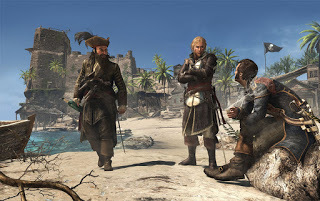
But modern scholarship doubt that Libertalia (or Libertatia) was ever a real place. Certainly there were pirate settlements on and around Madagascar, which Libertalia may have been based on: Abraham Samuel at Port Dauphin, Adam Baldridge at Ile Ste.-Marie, and James Plaintain at Ranter Bay were all ex-pirates who founded trading posts and towns. These locations appear frequently in official accounts and letters from the period, while Libertalia appears only in Johnson’s General History, Volume 2. Give the piratical tendency to – um – overstatement, especially when telling stories, the whole thing may be a myth.
But it’s a telling myth. A powerful statement about a desire for a bold social experiment, conceived by outlaws considered the dregs of society. It’s interesting to note that these pirates didn’t dream of fantastical wealth, ultimate power, or eternal life. All they wanted was a peaceful existence where no one took advantage of them.
So far, there has never been a serious archeological search for Libertalia. What would we do if we found it?
Enter Libertalia.

Libertalia was a legendary free colony forged by pirates. It was founded and ruled by the pirate Captain Misson (sometimes spelled Missin) a semi-legendary piratical figure described in The Robberies and Murders of the most Notorious Pyrates (1724).
Historian and activist Marcus Rediker describes the pirates as follows:These pirates who settled in Libertalia would be "vigilant Guardians of the People's Rights and Liberties"; they would stand as "Barriers against the Rich and Powerful" of their day. By waging war on behalf of "the Oppressed" against the "Oppressors," they would see that "Justice was equally distributed."

No one knows for sure if Libertatia actually existed. Pirates aren’t noted for keeping good records about their societies. But real or not, the radical ideas that it represented inspired undisputed real-life events. For example, after the American Revolution, a group of pirates fleeing from England were wrecked on an island and set up their own society. They called their new island "the Republic of Spensonia", after a fictional country created by the English author and political reformer Thomas Spence.

These pirates stood against monarchies, slavery, and capitalism as a way of distributing wealth. The pirates practiced a form of direct democracy, (one man one vote) where the crew held the authority to make laws and rules. Their system encouraged leaders to think of themselves as the equals, not the superiors, of those they led.
The pirates insisted that "every Man was born free, and had as much Right to what would support him, as to the Air he respired." They resented the "encroachments" by which "Villains" and "unmerciful Creditors" grew "immensely rich" as others became "wretchedly miserable." They spoke of the "Natural right" to "a Share of the Earth as is necessary for our Support." They saw piracy as a war of self-preservation, and had no need for money "where every Thing was in common, and no Hedge bounded any particular Man's Property," and they decreed that "the Treasure and Cattle they were Masters of should be equally divided."
Libertalia’s motto was said to be "for God and liberty," and its flag was white, in contrast to a Jolly Roger. Thecitizens were anarchists, waging war against states and lawmakers, attacking ships, sparing prisoners, and freeing slaves. It is said that Misson's crews often were equal parts African and European, as he did not support slavery. The pirates of Libertalia called themselves Liberi, and lived under a communal city rule, a sort of worker owned corporation of piracy. They had articles (shared codes of conduct), and used elected systems of re-callable delegates.

Captain Misson, founder of Libertalia, was French, born in Provence, while in Rome he ran into Caraccioli - a "lewd Priest" who gradually converted Misson and a sizeable portion of his crew to his way of thinking:
he fell upon Government, and shew'd, that every Man was born free, and had as much Right to what would support him, as to the Air he respired... that the vast Difference betwixt Man and Man, the one wallowing in Luxury, and the other in the most pinching Necessity, was owing only to Avarice and Ambition on the one Hand, and a pusillanimous Subjection on the other.
Convinced by the priest’s persuasion, the whole crew became pirates. They shared everything, including the ship, and freed the first cargo of slaves they encountered, urging the Africans to join them as brothers.
Off the coast of Madagascar, Misson found a perfect bay in an area with fertile soil, fresh water and friendly natives. Here the pirates built Libertalia. No more were they English, French, Dutch or African. They were Liberi. They created their own language, a polyglot mixture of African languages, combined with French, English, Dutch, Portuguese and native Malagasy.
 Thomas Tew
Thomas TewShortly after work on the colony began, they were joined by the pirate Thomas Tew. The Liberi - "Enemies to Slavery," aimed to boost their numbers by capturing another slave ship. Off the coast of Angola, Tew's crew took an English slave ship with 240 men, women and children below decks. The African members of the pirate crew found that many friends and relatives were among the formerly enslaved.
The pirates settled down to become farmers, holding the land in common - "no Hedge bounded any particular Man's Property." Prizes and money taken at sea were "carry'd into the common Treasury, Money being of no Use where every Thing was in common."
Was the colony real? The pirates of the time certainly believed it was. Members of the infamous “Flying Gang” who took Nassau in the Bahamas in 1715, and held it until 1718, claimed to anyone who would listen that they would “Make another Madagascar” of their new conquest.

But modern scholarship doubt that Libertalia (or Libertatia) was ever a real place. Certainly there were pirate settlements on and around Madagascar, which Libertalia may have been based on: Abraham Samuel at Port Dauphin, Adam Baldridge at Ile Ste.-Marie, and James Plaintain at Ranter Bay were all ex-pirates who founded trading posts and towns. These locations appear frequently in official accounts and letters from the period, while Libertalia appears only in Johnson’s General History, Volume 2. Give the piratical tendency to – um – overstatement, especially when telling stories, the whole thing may be a myth.
But it’s a telling myth. A powerful statement about a desire for a bold social experiment, conceived by outlaws considered the dregs of society. It’s interesting to note that these pirates didn’t dream of fantastical wealth, ultimate power, or eternal life. All they wanted was a peaceful existence where no one took advantage of them.
So far, there has never been a serious archeological search for Libertalia. What would we do if we found it?
Published on December 12, 2017 19:37
December 6, 2017
Fire Ship!
The Golden Age of Piracy was a time of wooden ships- wooden ships, held together with tar, and waterproofed with pitch. They were floating death traps, tinderboxes, piles of kindling. And they were filled with fire.
The galley, of course, kept a kitchen fire burning. The best kind of galleys had a floor lined with sheets of tin, an effort to keep sparks from setting the ship alight. Often the only “stove” was a steel box to hold the fire. The box might be sitting in a bed of sand – a known insulator – or it might contain sand, as a base for the fire.
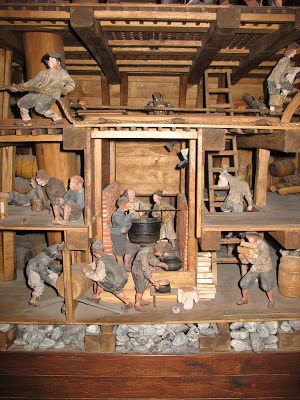 Cutaway model showing a ship's galley
Cutaway model showing a ship's galley
But the fire, a simple thing like a campfire, burned night and day. It was necessary to cook food for perhaps a hundred men, in a space perhaps six by six feet. Pots of boiling water were secured on the moving ship as well as they could be. An overturned pot could mean scalding wounds that meant almost certain death, either from the immediate injury, or, more horribly, from lingering infection.
But there was much more fire. Every light source was fire. Lanterns, candles, everyone was a possible source of conflagration for the entire ship.
Of course, precautions were taken. Simply the fact that almost all candles were confined behind glass was one. However, in these primitive times glass was sometimes not available. In this case, very thin pieces of animal horn, straightened by boiling or soaking in ammonia, were used as we might use plastic. Of course, this meant that the light of the candle behind the protective layer of horn was dimmed by the non-transparent layer, but it was better than setting the boat on fire.
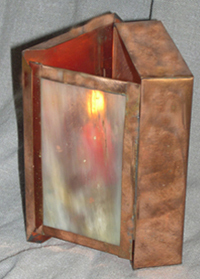 Lantern with a horn window
Lantern with a horn window
Smoking was also often prohibited. On merchant or navy ships smoking might be completely banned, but pirates embraced a more easygoing lifestyle. In order to allow their crews to smoke as they liked, pirate ships permitted the practice, but limited it to the open-air deck.
Some pirate ships even supported open-air smoking by providing their crews with a long, slow-burning fuse on deck, which made lighting a pipe easier. They also might provide a tub of wet sand for extinguishing pipes and cigars.
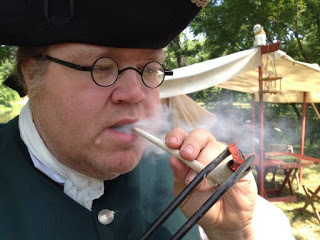
Most secure was the powder room. Home to the ship’s gunpowder, this room was as completely secure as the technology of the time could make it. Not only was it sealed tightly, but no lights -candles or lanterns. Instead, a window – leading into the rest of the ship, and covered with unbreakable horn, not delicate glass – let illumination in.
Anyone working in the powder room, either stowing supplies or handing gunpowder out to power the cannons during an attack, was required to take off all metal, which posed the danger of striking a spark. These people were also required to give up their shoes. Special slippers were used instead. Pirates didn’t yet understand that static sparks were electricity, but they did grasp that any spark at all could set off the powder and kill everyone on board.
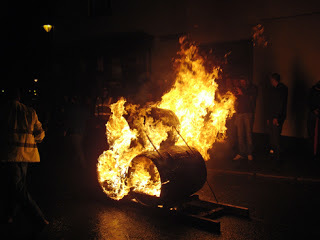 A barrel of pitch going up in flames
A barrel of pitch going up in flames
So what happen if a ship did catch on fire?
For one thing, there was little use putting it out. Literally everything on the boat was flammable. If the fire was tiny, someone might be able to throw drinking water on it. Or if it spread unusually slowly, someone might be able to set up the ship’s pumps to direct a stream of water on it.
But fires tend to go up, and that meant flames getting into the great canvas sails. The sails would burn, and drop flaming material all over. Unless luck was on the side of the sailors, the only thing to do was abandon ship.
If everyone was quick, the ship’s small boats could be lowered, and people could pile into them. If they weren’t so fortunate, the crew might find themselves in the water clinging to whatever was floating nearby.
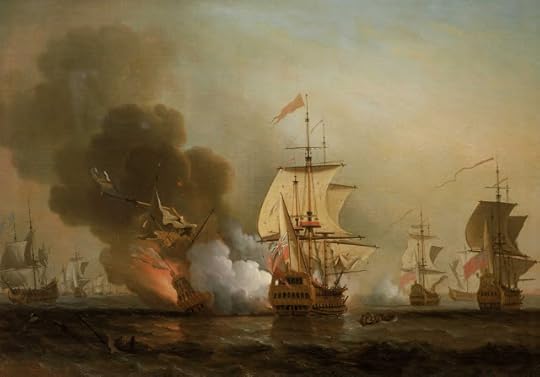 A ship blows up
A ship blows up
The boat might burn and sink. Or it might not sink quickly enough, and the gunpowder would explode.
Eyewitnesses to such events speak of the ship’s cannons, usually kept loaded, firing themselves one by one, set off by the intense heat.
An exploding powder magazine destroyed the entire ship instantly. Bodies of those unfortunate enough to still be aboard were torn to bit and thrown for as far as a mile. If any other ships were nearby, they would probably be set on fire by flying debris. The shockwave could be heard for miles. Humans anywhere in the vicinity were deafened for hours, even days, by the enormous blast of sound. An exploding ship was such a horrible event, it might leave witnesses with PTSD.
Pirates – and the military – were happy to put these horrifying facts to use. Setting an older, damaged, or un-needed ship on fire and sending it into a mass of enemy shipping was sure to start a panic. The secret was to steer the un-manned ship into enemy lines, while preventing the sails from catching on fire until it had crashed into the enemy. Doing so was a matter of both luck and skill.
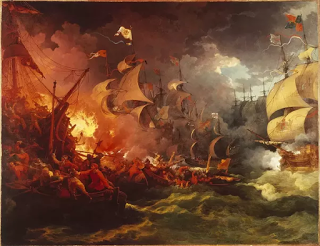 Armada hit by fire ships
Armada hit by fire ships
When Spain attacked England with an armada of 130 warships, Sir Francis Drake, pirate, admirable and English patriot, raided their supplies, then sent fire ships into the massed formations.
History credits storms for the destruction of this invading force, but Drake, his piratical crews, and their fire ships were at least equally responsible for turning back this invading force and changing the history of the world.
The galley, of course, kept a kitchen fire burning. The best kind of galleys had a floor lined with sheets of tin, an effort to keep sparks from setting the ship alight. Often the only “stove” was a steel box to hold the fire. The box might be sitting in a bed of sand – a known insulator – or it might contain sand, as a base for the fire.
 Cutaway model showing a ship's galley
Cutaway model showing a ship's galleyBut the fire, a simple thing like a campfire, burned night and day. It was necessary to cook food for perhaps a hundred men, in a space perhaps six by six feet. Pots of boiling water were secured on the moving ship as well as they could be. An overturned pot could mean scalding wounds that meant almost certain death, either from the immediate injury, or, more horribly, from lingering infection.
But there was much more fire. Every light source was fire. Lanterns, candles, everyone was a possible source of conflagration for the entire ship.
Of course, precautions were taken. Simply the fact that almost all candles were confined behind glass was one. However, in these primitive times glass was sometimes not available. In this case, very thin pieces of animal horn, straightened by boiling or soaking in ammonia, were used as we might use plastic. Of course, this meant that the light of the candle behind the protective layer of horn was dimmed by the non-transparent layer, but it was better than setting the boat on fire.
 Lantern with a horn window
Lantern with a horn windowSmoking was also often prohibited. On merchant or navy ships smoking might be completely banned, but pirates embraced a more easygoing lifestyle. In order to allow their crews to smoke as they liked, pirate ships permitted the practice, but limited it to the open-air deck.
Some pirate ships even supported open-air smoking by providing their crews with a long, slow-burning fuse on deck, which made lighting a pipe easier. They also might provide a tub of wet sand for extinguishing pipes and cigars.

Most secure was the powder room. Home to the ship’s gunpowder, this room was as completely secure as the technology of the time could make it. Not only was it sealed tightly, but no lights -candles or lanterns. Instead, a window – leading into the rest of the ship, and covered with unbreakable horn, not delicate glass – let illumination in.
Anyone working in the powder room, either stowing supplies or handing gunpowder out to power the cannons during an attack, was required to take off all metal, which posed the danger of striking a spark. These people were also required to give up their shoes. Special slippers were used instead. Pirates didn’t yet understand that static sparks were electricity, but they did grasp that any spark at all could set off the powder and kill everyone on board.
 A barrel of pitch going up in flames
A barrel of pitch going up in flamesSo what happen if a ship did catch on fire?
For one thing, there was little use putting it out. Literally everything on the boat was flammable. If the fire was tiny, someone might be able to throw drinking water on it. Or if it spread unusually slowly, someone might be able to set up the ship’s pumps to direct a stream of water on it.
But fires tend to go up, and that meant flames getting into the great canvas sails. The sails would burn, and drop flaming material all over. Unless luck was on the side of the sailors, the only thing to do was abandon ship.
If everyone was quick, the ship’s small boats could be lowered, and people could pile into them. If they weren’t so fortunate, the crew might find themselves in the water clinging to whatever was floating nearby.
 A ship blows up
A ship blows upThe boat might burn and sink. Or it might not sink quickly enough, and the gunpowder would explode.
Eyewitnesses to such events speak of the ship’s cannons, usually kept loaded, firing themselves one by one, set off by the intense heat.
An exploding powder magazine destroyed the entire ship instantly. Bodies of those unfortunate enough to still be aboard were torn to bit and thrown for as far as a mile. If any other ships were nearby, they would probably be set on fire by flying debris. The shockwave could be heard for miles. Humans anywhere in the vicinity were deafened for hours, even days, by the enormous blast of sound. An exploding ship was such a horrible event, it might leave witnesses with PTSD.
Pirates – and the military – were happy to put these horrifying facts to use. Setting an older, damaged, or un-needed ship on fire and sending it into a mass of enemy shipping was sure to start a panic. The secret was to steer the un-manned ship into enemy lines, while preventing the sails from catching on fire until it had crashed into the enemy. Doing so was a matter of both luck and skill.
 Armada hit by fire ships
Armada hit by fire shipsWhen Spain attacked England with an armada of 130 warships, Sir Francis Drake, pirate, admirable and English patriot, raided their supplies, then sent fire ships into the massed formations.
History credits storms for the destruction of this invading force, but Drake, his piratical crews, and their fire ships were at least equally responsible for turning back this invading force and changing the history of the world.
Published on December 06, 2017 21:34
November 28, 2017
Fried Chicken in the Pirate Era
As a person raised in the southern United States, it’s hard for me to imagine a time when fried chicken didn’t exist. It’s the perfect celebration food, a perfect picnic food (it travels well at room temperature) and has been on my table on Sundays for most of my life.

In fact, a Roman cookbook written in the 4th century contains a recipe for deep-fried chicken called Pullum Frontonianum. This dish, attributed to Apicius, a famous lover of good food, was probably an exotic treat for the well-to-do, rather than a weekly staple.
But most people agree that the first Europeans to really popularize deep fried chicken were the Scots.
They may or may not have been using the extra calories to fend off the notorious cold and wet weather of their homeland, but they also proved that they possessed something necessary for fried chicken – a reliable source of fat.
After all, this was an era when you couldn’t just go down to the store and buy a can of Crisco.
Animal fat was the order of the day, and you had to be the owner of healthy, well fed livestock to have enough fat available for deep-frying.

What created the fried chicken that we know today was contact between Europeans traders and African cooks. Because while the Scots deep fried their chickens, they did not use breading or spices. Africans, who had access to a wide variety of spices, cooked their chickens in palm oil, but they used breading and a spice mix to add interest. A typical West African spice mix might include paprika, various chilies, black pepper, and mint.
When Africans were taken as slaves, they were often given the undesirable job of cooking, and it didn’t take them long to improve on the Scottish method of deep-frying chickens in animal derived fat. In addition, slaves were sometimes allowed to keep their own chickens as livestock. This led to the pejorative association of fried chicken with African-American culture.

That’s too bad, because fried chicken is a gift we all appreciate. A perfectly fried piece of chicken, with its crisp, well-seasoned skin, tender and juicy meat, and comfort-food feel is about as good as it gets. We all enjoy it, so let’s give credit where it’s due.
But what has this to do with pirates?
Well, like those early slave-owners, pirates had what it took to make good fried chicken.
Ships were known to have an excess of food-grade fat available. When boiling the traditional meal of salted beef or pork, fat rose to the surface of the pot and was skimmed off by the ship’s cook. The material, called “slush” was considered the property of the cook, who often sold it when the ship was in port. The money made from this was called the “slush fund,” a term still in use today.
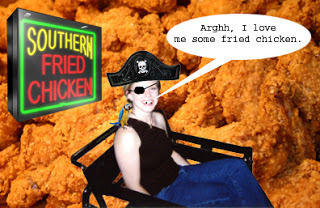
On a pirate ship, where the cook made a share of the profits, he could be assumed to be a lot more generous with his slush, so cooking in hot oil became a possibility. Pirates were also known to party on deserted beaches, where having a large pot of boiling oil would be safer than on the deck of a moving ship.
Also present were chickens. Merchant captains often kept a dozen or more birds alive on ship. The chickens provided eggs and fresh meat for the captain, and could be fed off crumbs of ship’s biscuit and the weevils that accumulated in the bread.
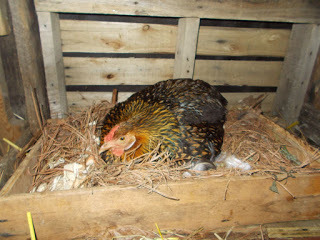
Pirate who captured a ship rich in chickens were likely to turn the creatures into meat. Part of this could be attributed to the “live for today” philosophy of the brigands, and part of it was the more pragmatic fact that any eggs laid would be too few for everyone to have a share.
Pirate ships often carried a high percentage of African crew members, whether as escaped slaves or simply as sailors whose ancestors came from Africa. And pirate cooks had access to a wide variety of expensive spices. After all, spices from the Caribbean were shipped all over the world, and captured spices didn’t have to be paid for.
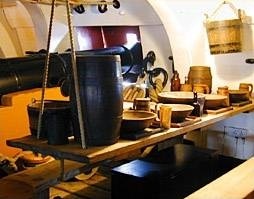 Ship's galleyA wide variety of sources confirm that pirates enjoyed spicy food and unusual taste combinations. So a pirate crew would be open to trying a Scottish dish with West African flair.
Ship's galleyA wide variety of sources confirm that pirates enjoyed spicy food and unusual taste combinations. So a pirate crew would be open to trying a Scottish dish with West African flair.
Fried chicken on a pirate ship. Who would have thought?
** I was inspired to write this blog while doing research for my series of novels - The Pirate Empire. Many folks have said that they learn as much from my fiction work as they have from other writer's non-fiction. Want to have even more fun while learning about Golden Age pirates? Pick up a copy of Gentlemen and Fortune. Available on Amazon now!
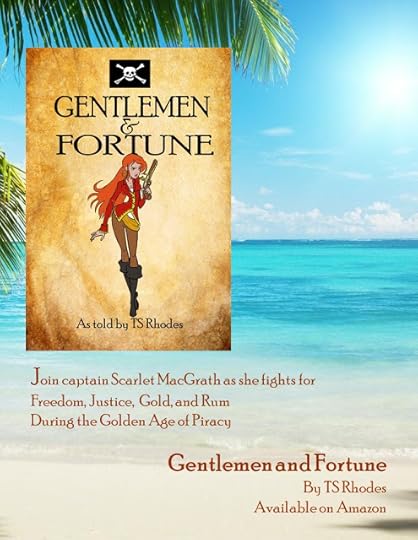

In fact, a Roman cookbook written in the 4th century contains a recipe for deep-fried chicken called Pullum Frontonianum. This dish, attributed to Apicius, a famous lover of good food, was probably an exotic treat for the well-to-do, rather than a weekly staple.
But most people agree that the first Europeans to really popularize deep fried chicken were the Scots.
They may or may not have been using the extra calories to fend off the notorious cold and wet weather of their homeland, but they also proved that they possessed something necessary for fried chicken – a reliable source of fat.
After all, this was an era when you couldn’t just go down to the store and buy a can of Crisco.
Animal fat was the order of the day, and you had to be the owner of healthy, well fed livestock to have enough fat available for deep-frying.

What created the fried chicken that we know today was contact between Europeans traders and African cooks. Because while the Scots deep fried their chickens, they did not use breading or spices. Africans, who had access to a wide variety of spices, cooked their chickens in palm oil, but they used breading and a spice mix to add interest. A typical West African spice mix might include paprika, various chilies, black pepper, and mint.
When Africans were taken as slaves, they were often given the undesirable job of cooking, and it didn’t take them long to improve on the Scottish method of deep-frying chickens in animal derived fat. In addition, slaves were sometimes allowed to keep their own chickens as livestock. This led to the pejorative association of fried chicken with African-American culture.

That’s too bad, because fried chicken is a gift we all appreciate. A perfectly fried piece of chicken, with its crisp, well-seasoned skin, tender and juicy meat, and comfort-food feel is about as good as it gets. We all enjoy it, so let’s give credit where it’s due.
But what has this to do with pirates?
Well, like those early slave-owners, pirates had what it took to make good fried chicken.
Ships were known to have an excess of food-grade fat available. When boiling the traditional meal of salted beef or pork, fat rose to the surface of the pot and was skimmed off by the ship’s cook. The material, called “slush” was considered the property of the cook, who often sold it when the ship was in port. The money made from this was called the “slush fund,” a term still in use today.

On a pirate ship, where the cook made a share of the profits, he could be assumed to be a lot more generous with his slush, so cooking in hot oil became a possibility. Pirates were also known to party on deserted beaches, where having a large pot of boiling oil would be safer than on the deck of a moving ship.
Also present were chickens. Merchant captains often kept a dozen or more birds alive on ship. The chickens provided eggs and fresh meat for the captain, and could be fed off crumbs of ship’s biscuit and the weevils that accumulated in the bread.

Pirate who captured a ship rich in chickens were likely to turn the creatures into meat. Part of this could be attributed to the “live for today” philosophy of the brigands, and part of it was the more pragmatic fact that any eggs laid would be too few for everyone to have a share.
Pirate ships often carried a high percentage of African crew members, whether as escaped slaves or simply as sailors whose ancestors came from Africa. And pirate cooks had access to a wide variety of expensive spices. After all, spices from the Caribbean were shipped all over the world, and captured spices didn’t have to be paid for.
 Ship's galleyA wide variety of sources confirm that pirates enjoyed spicy food and unusual taste combinations. So a pirate crew would be open to trying a Scottish dish with West African flair.
Ship's galleyA wide variety of sources confirm that pirates enjoyed spicy food and unusual taste combinations. So a pirate crew would be open to trying a Scottish dish with West African flair. Fried chicken on a pirate ship. Who would have thought?
** I was inspired to write this blog while doing research for my series of novels - The Pirate Empire. Many folks have said that they learn as much from my fiction work as they have from other writer's non-fiction. Want to have even more fun while learning about Golden Age pirates? Pick up a copy of Gentlemen and Fortune. Available on Amazon now!

Published on November 28, 2017 19:17
November 21, 2017
An apology to my readers. Due to flooding, I had to aband...
An apology to my readers. Due to flooding, I had to abandon my home for about 8 days, and then come back and make repairs. It’s all done now, thank goodness. I appreciate your patience.
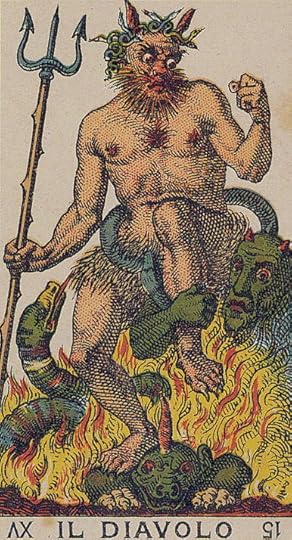
It is said that sailors did not like to speak the name of the Devil. Some people believe that naming a thing adds to its power (as in “he who will not be named.) For this reason, it is said, that sailors on general and pirates in particular, coined the name Davy Jones. Keeper of the infamous Davy Jones’ Locker.
The Locker, of course, it at the bottom of the sea – final resting place for drowned sailors. The seafaring men of the era had their own heaven – Fiddler’s Green – and their own hell as well. It’s consistent with their understanding of themselves as a breed apart. Sailors had an entirely different knowledge base than landsmen. They traveled far more – fragments of Chinese pottery in the 17th century ruins of Port Royal indicate that at least some of the pirates there had sailed to China. And they lived vastly different day-to-day lives.
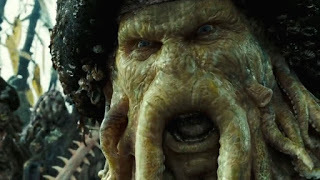
But I, personally, don’t agree with those who think that sailors were too afraid of the Devil to mention his name. In fact, there was a part of the called “The Devil”
I’ll explain what it was to the best of my landsman’s ability. It’s pretty easy to understand what the deck of a ship is. It’s the part that you usually stand on. The upper deck, which is open to the weather, is called the weather deck. The side of the ship – the outside – is called the hull. The place where the two meet is called the Devil.
This is an important part of the ship. The attachment of the hull to the decks is literally what holds everything together. Decks on wooden ships always had seams – the boards making up the deck. The devil-seam is the longest of them all. Because of its curve, it is actually longer than the boat. And it is also a place where water can enter the ship.
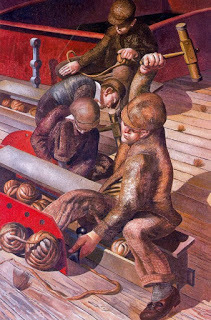
This gives us several interesting sayings. “Between the Devil and the Deep Blue Sea” is one. This saying has probably survived because it makes sense to the rest of us. The Devil is a bad person. The deep blue sea is dangerous. So being stuck between the Devil and the deep blue sea is not a good place to be.
But when you think of it in nautical terms, it becomes even worse. Because the “devil” is the very outside edge of the boat. The only thing between “the devil and the sea” is air. Not something you want to be trying to stand on. Add the fact that few 18th century sailors knew how to swim, and you have described a horrible situation. The moment when Wile E. Coyote realizes he’s standing on nothing, and plunges to his doom.

The other famous quote about this nautical “devil” is one you probably don’t associate with boats at all. “The Devil to pay” certainly gets its meaning across. After all, the Devil requires his due. So when things are looking bad, and someone says, “There’ll be the Devil to pay.” It surely signifies that someone is in trouble.
Well, not quite. Remember the devil-seam? Well, things on wooden boats need to be sealed so they are watertight. This is called “paying” them. In the case of a join between two pieces of wood, the common method of “paying’ was to stuff something into any large holes or cracks. Usually this was pieces of frayed rope – it’s already long, thin and flexible, and natural-fiber rope breaks down under the sun, saltwater and strain of shipboard use.

The second step of “paying” was to pour hot tar (a petroleum product) or pitch (pine tree sap, harvested for the purpose) into the frayed rope, and smooth it all down. The pitch made it watertight, while the fibrous material made it hold together better.
Both pitch and tar had to be heated, a difficult and dangerous thing on a moving ship. Vessels of the time were highly flammable, being made from dry wood, soaked in pitch and tar. Any fire presented a hazard. In addition, there were no safety measures for handling the scalding, sticky, flammable material.
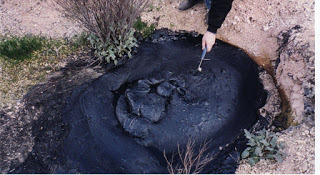 Tar bubbling up from the ground The pitch might be heated over a portable stove placed on the deck, in which case the pot might turn over due to the ship’s movement, spilling dangerously hot material over a deck mostly populated by men who were barefoot. Flying liquid could touch human’s skin, as well, for there was not much in the way of protective clothing, either, and it would stick to men’s skin, even as it burned them.
Tar bubbling up from the ground The pitch might be heated over a portable stove placed on the deck, in which case the pot might turn over due to the ship’s movement, spilling dangerously hot material over a deck mostly populated by men who were barefoot. Flying liquid could touch human’s skin, as well, for there was not much in the way of protective clothing, either, and it would stick to men’s skin, even as it burned them.
Carrying buckets of the stuff was little safer. The handles of pots would also be hot, and there were no safety-approved handguards. Rags were all that was available. If the material was heated on the galley stove and carried up to where it would be used, it would need to be carried up a ladder.
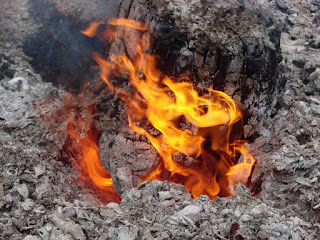 Burning pitch
Burning pitch
The full phrase isn’t just “The devil to pay.” It’s “the devil to pay and no pitch hot.” Meaning that sailors would have to go through the dangerous job of heating the pitch, and then the smelly, difficult, and only slightly less dangerous job of spreading it over the longest seam of the ship.
So my assentation is that sailors were plenty brave enough to talk about the Devil. They just found that too much of their regular work seemed to be inspired by him. Thank goodness that today we have better protection when performing dangerous work.

It is said that sailors did not like to speak the name of the Devil. Some people believe that naming a thing adds to its power (as in “he who will not be named.) For this reason, it is said, that sailors on general and pirates in particular, coined the name Davy Jones. Keeper of the infamous Davy Jones’ Locker.
The Locker, of course, it at the bottom of the sea – final resting place for drowned sailors. The seafaring men of the era had their own heaven – Fiddler’s Green – and their own hell as well. It’s consistent with their understanding of themselves as a breed apart. Sailors had an entirely different knowledge base than landsmen. They traveled far more – fragments of Chinese pottery in the 17th century ruins of Port Royal indicate that at least some of the pirates there had sailed to China. And they lived vastly different day-to-day lives.

But I, personally, don’t agree with those who think that sailors were too afraid of the Devil to mention his name. In fact, there was a part of the called “The Devil”
I’ll explain what it was to the best of my landsman’s ability. It’s pretty easy to understand what the deck of a ship is. It’s the part that you usually stand on. The upper deck, which is open to the weather, is called the weather deck. The side of the ship – the outside – is called the hull. The place where the two meet is called the Devil.
This is an important part of the ship. The attachment of the hull to the decks is literally what holds everything together. Decks on wooden ships always had seams – the boards making up the deck. The devil-seam is the longest of them all. Because of its curve, it is actually longer than the boat. And it is also a place where water can enter the ship.

This gives us several interesting sayings. “Between the Devil and the Deep Blue Sea” is one. This saying has probably survived because it makes sense to the rest of us. The Devil is a bad person. The deep blue sea is dangerous. So being stuck between the Devil and the deep blue sea is not a good place to be.
But when you think of it in nautical terms, it becomes even worse. Because the “devil” is the very outside edge of the boat. The only thing between “the devil and the sea” is air. Not something you want to be trying to stand on. Add the fact that few 18th century sailors knew how to swim, and you have described a horrible situation. The moment when Wile E. Coyote realizes he’s standing on nothing, and plunges to his doom.

The other famous quote about this nautical “devil” is one you probably don’t associate with boats at all. “The Devil to pay” certainly gets its meaning across. After all, the Devil requires his due. So when things are looking bad, and someone says, “There’ll be the Devil to pay.” It surely signifies that someone is in trouble.
Well, not quite. Remember the devil-seam? Well, things on wooden boats need to be sealed so they are watertight. This is called “paying” them. In the case of a join between two pieces of wood, the common method of “paying’ was to stuff something into any large holes or cracks. Usually this was pieces of frayed rope – it’s already long, thin and flexible, and natural-fiber rope breaks down under the sun, saltwater and strain of shipboard use.

The second step of “paying” was to pour hot tar (a petroleum product) or pitch (pine tree sap, harvested for the purpose) into the frayed rope, and smooth it all down. The pitch made it watertight, while the fibrous material made it hold together better.
Both pitch and tar had to be heated, a difficult and dangerous thing on a moving ship. Vessels of the time were highly flammable, being made from dry wood, soaked in pitch and tar. Any fire presented a hazard. In addition, there were no safety measures for handling the scalding, sticky, flammable material.
 Tar bubbling up from the ground The pitch might be heated over a portable stove placed on the deck, in which case the pot might turn over due to the ship’s movement, spilling dangerously hot material over a deck mostly populated by men who were barefoot. Flying liquid could touch human’s skin, as well, for there was not much in the way of protective clothing, either, and it would stick to men’s skin, even as it burned them.
Tar bubbling up from the ground The pitch might be heated over a portable stove placed on the deck, in which case the pot might turn over due to the ship’s movement, spilling dangerously hot material over a deck mostly populated by men who were barefoot. Flying liquid could touch human’s skin, as well, for there was not much in the way of protective clothing, either, and it would stick to men’s skin, even as it burned them.Carrying buckets of the stuff was little safer. The handles of pots would also be hot, and there were no safety-approved handguards. Rags were all that was available. If the material was heated on the galley stove and carried up to where it would be used, it would need to be carried up a ladder.
 Burning pitch
Burning pitchThe full phrase isn’t just “The devil to pay.” It’s “the devil to pay and no pitch hot.” Meaning that sailors would have to go through the dangerous job of heating the pitch, and then the smelly, difficult, and only slightly less dangerous job of spreading it over the longest seam of the ship.
So my assentation is that sailors were plenty brave enough to talk about the Devil. They just found that too much of their regular work seemed to be inspired by him. Thank goodness that today we have better protection when performing dangerous work.
Published on November 21, 2017 17:05
October 24, 2017
Pirate Headgear
I’ve written about how to make pirate hats, but I’ve never written about the actual fashion of pirate hats. By my reckoning, the Golden Age of Piracy spanned the time between 1690 and 1720. Fashion in mens’ hats changed over this time, but some things stayed the same.

To begin with, the basic structure of the man’s hat had not changed much since the early 1600’s. The basis of men’s hats was a large piece of heavy felt, shaped to the top of the head, with a wide brim. Some of the hats were round in the crown, and some were flat topped.
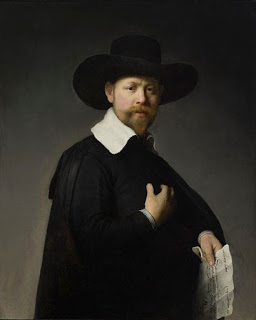
A major fashion divergence (in England) took place during the age of the Puritans and the English Civil War. Put very simply, this was a conflict between religious conservatives (who strongly supported a “plain” lifestyle and dress code) and Royalists, supporters of the English king, who espoused a more luxurious lifestyle.
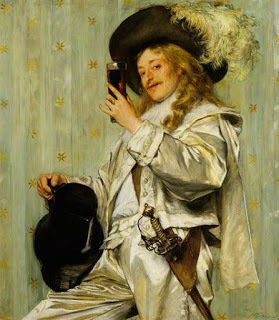
Of course, the political clash was much more complex. But the two sides showed their loyalties by their dress, especially their hats. In fact, the conservative religious side became known as “roundheads” for their tendency to wear their hats with the brims flat and the round crowns unadorned. In contrast, the Cavaliers adorned their hats and lavishly, especially with plumes. They also turned up the brims of their hats in a fashionable manner.
By the late 1600’s, the style – for the stylish – was to turn up the brim of the hat in 3 sections, making the early form that we know as the “tricorn” – literally “three horned” from the three points made by the turned-up sides.
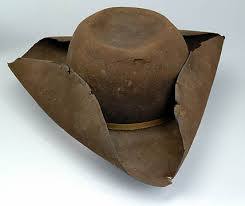 A very battered fabric tricorn
A very battered fabric tricorn
This is the form that we most strongly associate with pirates. But pirates did not in any way have a monopoly on these hats. In fact, throughout most of the Golden Age, pirates wore hats of this shape simply because, if a person set out to buy a “men’s hat” this is what they would be offered.
The style had first come into use during warfare between France and Spain during the 1650’s. The style then moved to France where it became “fashionable.”
The English tended to offer these hats plain- with no more than a contrasting colored trim around the edge of the brim. Italians tended more toward metallic trims around the brims, while the French added a fluffy feathered detail all around the edge of the brim.
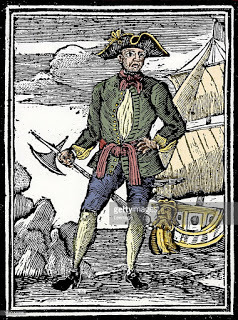
Now, how did pirates use these hats?
In the first place sailors did not wear their hats in the same way as landsmen. Today, we see hats worn always with one of the tips pointing perfectly forward, directly over the wearer’s nose. But men did not always wear their hats this way. For example, soldiers who marched with a rifle or musket on their shoulders, put the flat side of the hat on that side. This made it less likely that they would knock the hat off with the musket. It also gave the front of the hat an odd, lopsided look, with the front point off center.
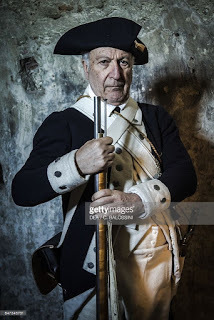
Sailors wore their hats with a flat side in front, and a point in the back. This looks strange to us, but it allowed the wearer to work in close quarters without knocking the hat off. The point coming over the owner’s neck may also have offered some protection from the sun.
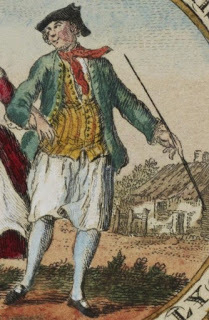
However, hats were expensive, and many plain sailors wore a simple fabric cap with a narrow brim. Owning a real hat would have been a step up that pirates might aspire to.
Working pirates also probably wore some kind of bandana or fabric headband. This was for the pragmatic reason of keeping sweat out of the eyes. Pirates had more money to buy scarves with, and may also have cut down stolen clothing to make brightly colored head scarves. People of the time valued bright colors, because they were expensive as well as being pretty.
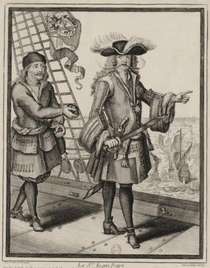 A captain and a common sailor
A captain and a common sailor
As well as hats, rich men also wore huge, elaborate wigs. There is some contention as to whether pirate captains wore these wigs or not. To people of the time, it would seem entirely natural that a person in authority. But pirate captains often came from working-class backgrounds. They may have valued the comfort of a wig-less existence, and profited from a more egalitarian look among their men.
It does seem, however, that lower-tier pirates wore the wigs during attacks. The startling look of tanned, hard-bitten men in elegant wigs must have been startling, even frightening to pirate victims. This may be a reason why pirates would have favored the most elaborate hats that they could lay hands on. Since they didn’t have to pay for them, they could afford the very best.

To begin with, the basic structure of the man’s hat had not changed much since the early 1600’s. The basis of men’s hats was a large piece of heavy felt, shaped to the top of the head, with a wide brim. Some of the hats were round in the crown, and some were flat topped.

A major fashion divergence (in England) took place during the age of the Puritans and the English Civil War. Put very simply, this was a conflict between religious conservatives (who strongly supported a “plain” lifestyle and dress code) and Royalists, supporters of the English king, who espoused a more luxurious lifestyle.

Of course, the political clash was much more complex. But the two sides showed their loyalties by their dress, especially their hats. In fact, the conservative religious side became known as “roundheads” for their tendency to wear their hats with the brims flat and the round crowns unadorned. In contrast, the Cavaliers adorned their hats and lavishly, especially with plumes. They also turned up the brims of their hats in a fashionable manner.
By the late 1600’s, the style – for the stylish – was to turn up the brim of the hat in 3 sections, making the early form that we know as the “tricorn” – literally “three horned” from the three points made by the turned-up sides.
 A very battered fabric tricorn
A very battered fabric tricornThis is the form that we most strongly associate with pirates. But pirates did not in any way have a monopoly on these hats. In fact, throughout most of the Golden Age, pirates wore hats of this shape simply because, if a person set out to buy a “men’s hat” this is what they would be offered.
The style had first come into use during warfare between France and Spain during the 1650’s. The style then moved to France where it became “fashionable.”
The English tended to offer these hats plain- with no more than a contrasting colored trim around the edge of the brim. Italians tended more toward metallic trims around the brims, while the French added a fluffy feathered detail all around the edge of the brim.

Now, how did pirates use these hats?
In the first place sailors did not wear their hats in the same way as landsmen. Today, we see hats worn always with one of the tips pointing perfectly forward, directly over the wearer’s nose. But men did not always wear their hats this way. For example, soldiers who marched with a rifle or musket on their shoulders, put the flat side of the hat on that side. This made it less likely that they would knock the hat off with the musket. It also gave the front of the hat an odd, lopsided look, with the front point off center.

Sailors wore their hats with a flat side in front, and a point in the back. This looks strange to us, but it allowed the wearer to work in close quarters without knocking the hat off. The point coming over the owner’s neck may also have offered some protection from the sun.

However, hats were expensive, and many plain sailors wore a simple fabric cap with a narrow brim. Owning a real hat would have been a step up that pirates might aspire to.
Working pirates also probably wore some kind of bandana or fabric headband. This was for the pragmatic reason of keeping sweat out of the eyes. Pirates had more money to buy scarves with, and may also have cut down stolen clothing to make brightly colored head scarves. People of the time valued bright colors, because they were expensive as well as being pretty.
 A captain and a common sailor
A captain and a common sailorAs well as hats, rich men also wore huge, elaborate wigs. There is some contention as to whether pirate captains wore these wigs or not. To people of the time, it would seem entirely natural that a person in authority. But pirate captains often came from working-class backgrounds. They may have valued the comfort of a wig-less existence, and profited from a more egalitarian look among their men.
It does seem, however, that lower-tier pirates wore the wigs during attacks. The startling look of tanned, hard-bitten men in elegant wigs must have been startling, even frightening to pirate victims. This may be a reason why pirates would have favored the most elaborate hats that they could lay hands on. Since they didn’t have to pay for them, they could afford the very best.
Published on October 24, 2017 20:56
October 17, 2017
Pictures, Pirates and Bunny Ears
Why do I write this blog?
I began this blog over four years ago because I was researching the pirate books I was writing, and had discovered so many really cool facts about the Golden Age of Piracy that I wanted to share. As I have learned more, I’ve celebrated pirates in pop culture – always an interesting topic – and delved into several aspects of 18th century life.
This last is one of my longest-lasting topics. It has become one of my goals to help people to see what was going on in the heads of people who became pirates, even as I try to understand that myself.
Because people are products of their time and place. No matter how much we strive to be individuals, or to rebel, our surroundings influence us in ways we may never realize, and can even steer us by giving us something to rebel against.
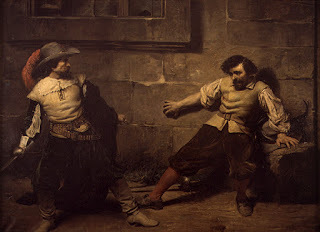
Even today, lingering echoes from hundreds of years ago influence our thoughts and feelings.
And that brings us to bunny ears.
You all know the pictures where one person puts their fingers behind another person’s head, so it looks like their friend is wearing a pair of rabbit ears. Everyone knows it’s kind of a naughty thing to do, but no one seems to know why.
People did something similar in the 17th and 18thcentury, although of course, it was done in paintings and engravings. Why? Because in the 18th century, it mean something quite specific. It meant that the guy’s wife was cheating on him.
The two fingers were not bunny ears. They were horns.
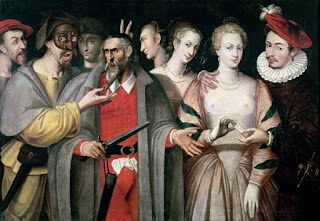 This is a really old painting
This is a really old painting
The phrase “putting horn on him” is supposed to come from Spain, specifically Andalusia, and even in modern times, men there use it to mean that their wives are fooling around. Supposedly,
Andalusian men don’t like to be seen in public rubbing or scratching their foreheads, because folk might think that they are spontaneously growing horns.
So what do male horns have to do with female sex?
The phrase is so old, it’s hard to tell. My favorite explanation is that Andalusia is an area with many goats. Female goats, unlike female sheep, have horns, and goat’s horns have long symbolized the devil. In this instance, the horns also symbolize female power, specifically female sexual power, which has terrified men at least since the Dark Ages.
 A woman with and "evil" hairdo, looking like hornsIn this version of the story, the wife, who is acting the part of a man by fooling around, “puts” the feminine horns on her husband, signify that he must now take the female role of standing by while his spouse takes lovers.
A woman with and "evil" hairdo, looking like hornsIn this version of the story, the wife, who is acting the part of a man by fooling around, “puts” the feminine horns on her husband, signify that he must now take the female role of standing by while his spouse takes lovers.
This may seem very far-fetched, and almost Freudian. But one thing is certain. However the phrase came to be, people of the early 1700’s were very familiar with the phrase, the image, and its meaning.
In this section of Hogarth’s “Four Times of Day – Afternoon” we see an example of the phrase’s usage in art. The picture show a family visiting a tourist town. Like many families on holiday, things aren’t working out well. The wife, pregnant, is overdressed, hot and uncomfortable. The kids are crying. The husband, struggling to carry a toddler, looks exhausted.
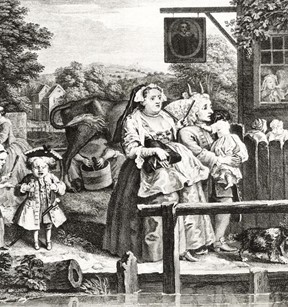
But if you look closely, you will see that a cow has been strategically placed behind him, so that its horns appear to be growing out of his head. Hogarth loved to put telling details and visual jokes in his paintings and prints, and this one shares the information that this man is caring for children who are not his own.
It is, if you will, a very early example of “bunny ears” in a picture.
Not only did pictures show things like this, but people used it in real life. There is a story of a French nobleman whose wife began an affair with the King. Now, normally husbands liked it when their wives had a royal affair. Few aristocratic marriages were love-matches, so there was not necessarily any betrayal of affection involved. And Kings were known to reward accommodating husbands by giving them titles, land, and other desirable goodies.
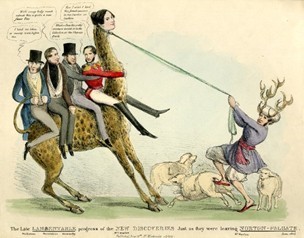 A woman (as a giraffe) her husband (in the horns)
A woman (as a giraffe) her husband (in the horns)
and the men who are "riding" her.
But this particular nobleman was not happy that his wife was sleeping with another man. So he had a pair of stag’s horns attached to the top of his carriage, and rode through Paris, showing off the fact that his wife wasn’t faithful and he was unhappy about it.
Some people say that, by the early 1700’s the exact meaning that the wife was “putting horns on her husband” had loosened just a little. By this time, a man was able to point out that another man was wearing horns. And the fact of pointing it out brought in a possible additional meaning.
“Your wife is having an affair with ME.”
Today the sense of wickedness in putting up “bunny ears” still exists. But if you’re a pirate, remember that things were different 300 years ago. Be careful in those photos!
I began this blog over four years ago because I was researching the pirate books I was writing, and had discovered so many really cool facts about the Golden Age of Piracy that I wanted to share. As I have learned more, I’ve celebrated pirates in pop culture – always an interesting topic – and delved into several aspects of 18th century life.
This last is one of my longest-lasting topics. It has become one of my goals to help people to see what was going on in the heads of people who became pirates, even as I try to understand that myself.
Because people are products of their time and place. No matter how much we strive to be individuals, or to rebel, our surroundings influence us in ways we may never realize, and can even steer us by giving us something to rebel against.

Even today, lingering echoes from hundreds of years ago influence our thoughts and feelings.
And that brings us to bunny ears.
You all know the pictures where one person puts their fingers behind another person’s head, so it looks like their friend is wearing a pair of rabbit ears. Everyone knows it’s kind of a naughty thing to do, but no one seems to know why.
People did something similar in the 17th and 18thcentury, although of course, it was done in paintings and engravings. Why? Because in the 18th century, it mean something quite specific. It meant that the guy’s wife was cheating on him.
The two fingers were not bunny ears. They were horns.
 This is a really old painting
This is a really old paintingThe phrase “putting horn on him” is supposed to come from Spain, specifically Andalusia, and even in modern times, men there use it to mean that their wives are fooling around. Supposedly,
Andalusian men don’t like to be seen in public rubbing or scratching their foreheads, because folk might think that they are spontaneously growing horns.
So what do male horns have to do with female sex?
The phrase is so old, it’s hard to tell. My favorite explanation is that Andalusia is an area with many goats. Female goats, unlike female sheep, have horns, and goat’s horns have long symbolized the devil. In this instance, the horns also symbolize female power, specifically female sexual power, which has terrified men at least since the Dark Ages.
 A woman with and "evil" hairdo, looking like hornsIn this version of the story, the wife, who is acting the part of a man by fooling around, “puts” the feminine horns on her husband, signify that he must now take the female role of standing by while his spouse takes lovers.
A woman with and "evil" hairdo, looking like hornsIn this version of the story, the wife, who is acting the part of a man by fooling around, “puts” the feminine horns on her husband, signify that he must now take the female role of standing by while his spouse takes lovers.This may seem very far-fetched, and almost Freudian. But one thing is certain. However the phrase came to be, people of the early 1700’s were very familiar with the phrase, the image, and its meaning.
In this section of Hogarth’s “Four Times of Day – Afternoon” we see an example of the phrase’s usage in art. The picture show a family visiting a tourist town. Like many families on holiday, things aren’t working out well. The wife, pregnant, is overdressed, hot and uncomfortable. The kids are crying. The husband, struggling to carry a toddler, looks exhausted.

But if you look closely, you will see that a cow has been strategically placed behind him, so that its horns appear to be growing out of his head. Hogarth loved to put telling details and visual jokes in his paintings and prints, and this one shares the information that this man is caring for children who are not his own.
It is, if you will, a very early example of “bunny ears” in a picture.
Not only did pictures show things like this, but people used it in real life. There is a story of a French nobleman whose wife began an affair with the King. Now, normally husbands liked it when their wives had a royal affair. Few aristocratic marriages were love-matches, so there was not necessarily any betrayal of affection involved. And Kings were known to reward accommodating husbands by giving them titles, land, and other desirable goodies.
 A woman (as a giraffe) her husband (in the horns)
A woman (as a giraffe) her husband (in the horns) and the men who are "riding" her.
But this particular nobleman was not happy that his wife was sleeping with another man. So he had a pair of stag’s horns attached to the top of his carriage, and rode through Paris, showing off the fact that his wife wasn’t faithful and he was unhappy about it.
Some people say that, by the early 1700’s the exact meaning that the wife was “putting horns on her husband” had loosened just a little. By this time, a man was able to point out that another man was wearing horns. And the fact of pointing it out brought in a possible additional meaning.
“Your wife is having an affair with ME.”
Today the sense of wickedness in putting up “bunny ears” still exists. But if you’re a pirate, remember that things were different 300 years ago. Be careful in those photos!
Published on October 17, 2017 20:17
October 10, 2017
Lady Pirate – Mary/Elizabeth Killigrew
The rocky coast of Cornwall (in England) has been home to smugglers and wreckers for as long as anyone can remember. It was also home to a strong female pirate – Mary (sometimes Elizabeth) Killigrew.
 Lady Mary
Lady Mary
Mary was the daughter of a Phillip Wolverton, Lord of Wolverton Hall, and a former Suffolk pirate. She was born some time before 1525, and was married to Henry Knyvett, who died in 1547.
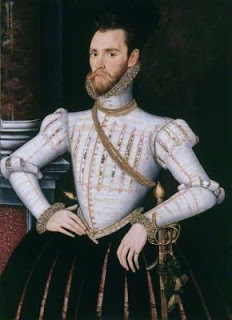 Henry Knyvett
Henry Knyvett
Mary's second husband was Sir Henry Killigrew, a pirate who was later made a Vice-Admiral by Queen Elizabeth I. These were the days when piracy was something of a national pastime in England. Because of its official Protestant religion, (among other things) England was at odds with Spain, and Spain was in the process of looting gold, silver and emeralds from the New World. There was money to be made in stealing from Spain.
Sir Henry was heir to Arwenack castle, a Cornish stronghold near what is now the town of Falmouth, and in a position to control the mouth of the river Fal – the third-largest natural port in the world.
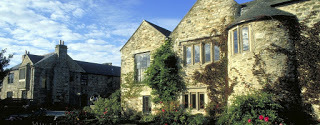 Arwenack House
Arwenack House
Sir Henry had been in trouble under Queen Mary, the last Catholic queen of England. He and his father were even imprisoned for their opposition, though their actual jailtime amounted to only 3 weeks. When Elizabeth I, a Protestant, came to the throne, the Killigrews were back in favor.
Not that any of them were angels. A national beauty in her day, with her long auburn hair, Lady Mary Killigrew became Cornwall’s own super villain (or hero, if you like); leading a double life as noble aristocrat by day and ruthless pirate by night! It is said that she often entertained nobles and ship captains in order to extract information about treasure. Both she and her husband used this information later in their robberies. Lady Mary was said to love the excitement.
Under Elizabeth’s protection, Sir Henry became notorious for engaging in cattle theft, "evil usage in keeping of a castle" and for abuses of his power as a Justice of the peace. By the time he was appointed a Commissioner to inquire into piracy, he was heavily engaged in that activity himself, and traded with smugglers and pirates who frequented the waters around his home castle. He was the subject of an official investigation in 1565.
But pirates brought money into the royal coffers (good pirates of the period kicked back to the ruler they sailed under) but appearances must be maintained. Elizabeth I needed to placate her Spanish peers, even as she was accepting money from men like Francis Drake.
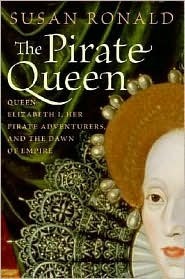 Elizabeth had her reputation, too.
Elizabeth had her reputation, too.
Mary was, by all accounts, an enthusiastic supporter of her husband’s less than legal activities. She re-designed Arwenak to better hold stolen goods, cut deals with smugglers, and occasionally sent her servants out to raid ships driven into the huge natural harbor by storm or other misfortune. It’s possible that all this took place with Queen Elizabeth’s approval, or at least while she turned a blind eye.
The final straw, however, came in 1570.
A ship came in to the Far-mouth harbor, sadly knocked about from a major storm, possible dismasted. Some sources call the ship a German merchant. Others say the ship was Spanish (which I believe is the more likely.) Mary was at home with only her servants – Sir Henry was out pirating.
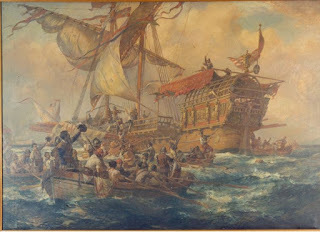 Raid on a Spanish treasure ship
Raid on a Spanish treasure ship
Seeing the opportunity to make a huge profit, Mary sent a raiding party out in the dead of night to capture the ship. The more romantic pirate fans say she led the attack herself. This is unlikely, though she probably planned it. And who knows? There's no proof she didn't either.
Her men did not do things halfway. They not only captured the ship’s cargo, but the ship itself. After unloading their plunder, they supposedly sailed the ship to Ireland to sell it. With all the cargo hidden in a castle, and the ship itself sold far away, it looked like the perfect crime.
But the ship’s owner went directly to the Queen. Faced with such obvious evidence of piracy (the robbing and stealing of the ship) something, at last, had to be done.
(This, by the way, is why I believe the ship was not German. Germany wasn’t even a country yet… Nobody cared if the Germans were angry. Rich, powerful Spain, however, was another matter.)
Queen Elizabeth had Lady Mary arrested and brought to trial. Some sources say she was sentenced to death and then pardoned by the Queen. Others say her family bribed the jurors and she was acquitted. (The family had been bribing government officials to cover up their nefarious activities for generations. Piracy is profitable enough to make that kind of thing possible.) Whether due to bribes or the efforts of Queen Elizabeth, Mary served only a short term in prison, though two of her servants were hanged.
 Lady Mary
Lady Mary
It was about this time that Mary began to be known as Elizabeth. This has confused historians, and everyone else, and many sources speak of Mary and Elizabeth Killigrew as two separate female pirates. But these were times when changing one’s name was pretty much as simple as asking people to call you something else. Did Mary, bearing the name of Elizabeth’s former rival, change her name to Elizabeth to curry royal favor? We will likely never know, but it seems plausible.
Whatever transpired, Mary gave up pirating and spent the rest of her life storing her husband’s ill-gotten gains and fencing stolen goods, until she died several years later.
 Lady Mary
Lady MaryMary was the daughter of a Phillip Wolverton, Lord of Wolverton Hall, and a former Suffolk pirate. She was born some time before 1525, and was married to Henry Knyvett, who died in 1547.
 Henry Knyvett
Henry KnyvettMary's second husband was Sir Henry Killigrew, a pirate who was later made a Vice-Admiral by Queen Elizabeth I. These were the days when piracy was something of a national pastime in England. Because of its official Protestant religion, (among other things) England was at odds with Spain, and Spain was in the process of looting gold, silver and emeralds from the New World. There was money to be made in stealing from Spain.
Sir Henry was heir to Arwenack castle, a Cornish stronghold near what is now the town of Falmouth, and in a position to control the mouth of the river Fal – the third-largest natural port in the world.
 Arwenack House
Arwenack HouseSir Henry had been in trouble under Queen Mary, the last Catholic queen of England. He and his father were even imprisoned for their opposition, though their actual jailtime amounted to only 3 weeks. When Elizabeth I, a Protestant, came to the throne, the Killigrews were back in favor.
Not that any of them were angels. A national beauty in her day, with her long auburn hair, Lady Mary Killigrew became Cornwall’s own super villain (or hero, if you like); leading a double life as noble aristocrat by day and ruthless pirate by night! It is said that she often entertained nobles and ship captains in order to extract information about treasure. Both she and her husband used this information later in their robberies. Lady Mary was said to love the excitement.
Under Elizabeth’s protection, Sir Henry became notorious for engaging in cattle theft, "evil usage in keeping of a castle" and for abuses of his power as a Justice of the peace. By the time he was appointed a Commissioner to inquire into piracy, he was heavily engaged in that activity himself, and traded with smugglers and pirates who frequented the waters around his home castle. He was the subject of an official investigation in 1565.
But pirates brought money into the royal coffers (good pirates of the period kicked back to the ruler they sailed under) but appearances must be maintained. Elizabeth I needed to placate her Spanish peers, even as she was accepting money from men like Francis Drake.
 Elizabeth had her reputation, too.
Elizabeth had her reputation, too.Mary was, by all accounts, an enthusiastic supporter of her husband’s less than legal activities. She re-designed Arwenak to better hold stolen goods, cut deals with smugglers, and occasionally sent her servants out to raid ships driven into the huge natural harbor by storm or other misfortune. It’s possible that all this took place with Queen Elizabeth’s approval, or at least while she turned a blind eye.
The final straw, however, came in 1570.
A ship came in to the Far-mouth harbor, sadly knocked about from a major storm, possible dismasted. Some sources call the ship a German merchant. Others say the ship was Spanish (which I believe is the more likely.) Mary was at home with only her servants – Sir Henry was out pirating.
 Raid on a Spanish treasure ship
Raid on a Spanish treasure shipSeeing the opportunity to make a huge profit, Mary sent a raiding party out in the dead of night to capture the ship. The more romantic pirate fans say she led the attack herself. This is unlikely, though she probably planned it. And who knows? There's no proof she didn't either.
Her men did not do things halfway. They not only captured the ship’s cargo, but the ship itself. After unloading their plunder, they supposedly sailed the ship to Ireland to sell it. With all the cargo hidden in a castle, and the ship itself sold far away, it looked like the perfect crime.
But the ship’s owner went directly to the Queen. Faced with such obvious evidence of piracy (the robbing and stealing of the ship) something, at last, had to be done.
(This, by the way, is why I believe the ship was not German. Germany wasn’t even a country yet… Nobody cared if the Germans were angry. Rich, powerful Spain, however, was another matter.)
Queen Elizabeth had Lady Mary arrested and brought to trial. Some sources say she was sentenced to death and then pardoned by the Queen. Others say her family bribed the jurors and she was acquitted. (The family had been bribing government officials to cover up their nefarious activities for generations. Piracy is profitable enough to make that kind of thing possible.) Whether due to bribes or the efforts of Queen Elizabeth, Mary served only a short term in prison, though two of her servants were hanged.
 Lady Mary
Lady MaryIt was about this time that Mary began to be known as Elizabeth. This has confused historians, and everyone else, and many sources speak of Mary and Elizabeth Killigrew as two separate female pirates. But these were times when changing one’s name was pretty much as simple as asking people to call you something else. Did Mary, bearing the name of Elizabeth’s former rival, change her name to Elizabeth to curry royal favor? We will likely never know, but it seems plausible.
Whatever transpired, Mary gave up pirating and spent the rest of her life storing her husband’s ill-gotten gains and fencing stolen goods, until she died several years later.
Published on October 10, 2017 20:38



